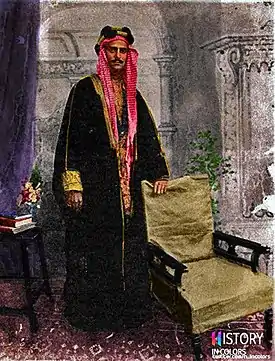 Sheikh Chassib, son of Sheikh Khazʿal bin Jaber, Crown Prince of the Emirate of Mohammerah, wearing the adorned bisht affiliated with the clothing, in a picture of 1923. | |
| Type | Arab clothing |
|---|---|
| Material | Camel hair and Goat wool and for the wealthy pure gold thread |
| Place of origin | Arabian peninsula |
| Introduced | 2300 BCE |
A bisht (Arabic: بِشْت; plural: بِشُوت bishūt and بْشُوت bshūt), known in some Arabic spoken dialects as mishlaḥ (Arabic: مِشْلَح) or ʿabāʾ (Arabic: عَبَاء), is a traditional men’s cloak popular in the Arab world, and worn in general for thousands of years.[1][2]
According to ancient Christian and Hebrew paintings, a similar robe was worn in the days of Jesus by the people of the Levant.
The bisht is a flowing outer cloak worn over a thawb.
Symbol of Arab identity
A bisht is usually worn for prestige on special occasions such as weddings, or festivals such as Eid, or for Ṣalāt al-Jumuʿah or Salat al-Janazah. It is usually worn by secular officials or clergy,[1] including tribal chiefs, kings, and imams over a thawb, kanzu or tunic. It is a status garment, associated with royalty, religious position, wealth, and ceremonial occasions such as weddings, like the black-tie tuxedo[3] in the West.[1][4]
Etymology
The triliteral root of the word bisht is widely used in Semitic languages, including Arabic, and is related to the Akkadian bishtu, meaning 'nobility' or 'dignity'.[5]
The alternate name of ʿabāʾ (Arabic: عَبَاء) is from the Arabic triliteral root ʿAyn-Bāʾ-Wāw, which relates to 'filling out'.
Colour
It is usually black, brown, beige, cream or grey in colour. However, there are Bishts which are made in colours like magenta, blue, cyan, and others.[1]
Manufacturing
Bisht is made from camel's hair and goat wool that is spun and wove into a breathable fabric. Some bisht garments include a trim, known as "zari", made out of silk and metals such as gold and silver.[6]
The fabric has a soft yarn for the summer and the coarse-haired for winter.
In popular culture
In the 2022 FIFA World Cup final, Qatari Emir Tamim bin Hamad Al Thani placed a bisht on the Argentine captain Lionel Messi before the 35-year-old was handed the trophy.
See also
References
- 1 2 3 4 Al-Mukhtar, Rima (7 November 2012). "Traditional & modern: The Saudi man's bisht". Arab News.
- ↑
- Urbanarabian. "B – Sweater – Over Sized Sweater". Urbanarabian. Archived from the original on 2016-09-11. Retrieved 2016-05-23.
- Hannah (27 April 2011). "Saudi Arabian Bisht".
- "صانع بشوت الحكام وكبار الشخصيات "البراهيم" لـ"الأحساء نيوز":صنعت بشت الملك فهد وابنه – صحيفة الأحساء نيوز". www.hasanews.com. Archived from the original on 2022-12-19. Retrieved 2016-05-23.
- "الثقافة الشعبية". www.folkculturebh.org.
- "البشت في الخليج العربي". www.abuhaleeqa.net. Archived from the original on 2019-11-15. Retrieved 2016-05-23.
- ناصر حسين العبّودي (1987). الأزياء الشعبية الرجالية في دولة الإمارات وسلطنة عمان. مركز التراث الشعبي لدول الخليج العربية،. pp. 121, 127, 129.
- ناصر حسين العبّودي (1987). الازياء الشعبية الرجالية في دولة الامارات وسلطنة عمان. pp. 121, 127, 129.
- "الازياء الشعبية الرجالية فى دولة الامارات و سلطنة عمان 3.1.2". Bibliotheca Alexandrina. 4 June 2016. Archived from the original on 4 June 2016.
- "كتاب الازياء الشعبية الرجالية في دولة الإمارات وسلطنة عمان". التبراة : عالم الكتب.
- "PDF document". raya.com (in Arabic). 10 August 2016. Archived from the original on 10 August 2016.
- Najlā Ismāʻīl al-ʻIzzī al-Wahhābī (2003). أزياء قطرية. جمعية الفن الإسلامي،. p. 12. ISBN 978-0-9544445-2-5.
- S. D. Goitein (1983). A Mediterranean Society: Daily life. University of California Press. p. 464. ISBN 978-0-520-04869-0.
- Abū al-Maḥāsin Yūsuf Ibn Taghrībirdī (1960). History of Egypt, 1382-1469 A.D.: 1382-1399 A.D. University of California Press. p. 108.
- ↑ "Kate dusts off her Alexander McQueen tuxedo for stunning appearance". Evening Standard. 2020-10-13. Retrieved 2020-10-15.
- ↑ "A symbol of Arab identity". Gulf News. Retrieved 2020-10-15.
- ↑ Dr. Ali Fahmi khashim, Akkadian Arabic Dictionary Page 140
- ↑ Mahdavi, Pardis. "Lionel Messi's black cloak: a brief history of the bisht, given to the superstar after his World Cup triumph". The Conversation. Retrieved 2022-12-28.